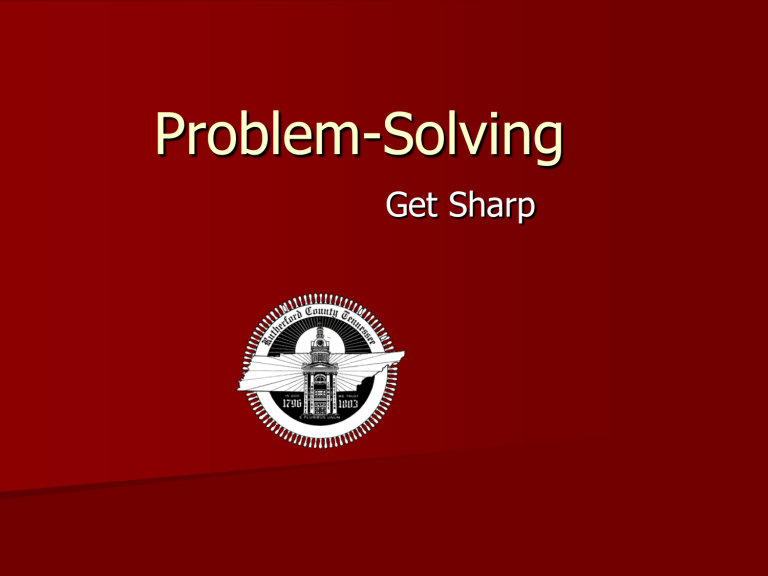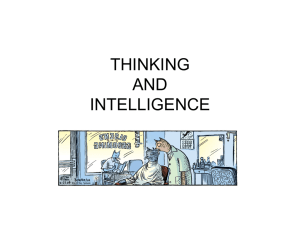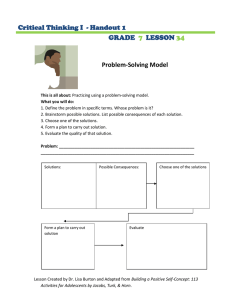
Problem-Solving Get Sharp Agenda Training Objectives: Understand key terms in problem-solving Discover steps to accelerate your learning Learn the types of questions you will need to master Develop problem-solving techniques Key Terms Problem-Solving Critical Thinking Creative Thinking Strategic Thinking Decision-Making Problem-Solving Involves using higher-order thinking skills to effectively handle and critically work out realistic solutions to problems. - Is a basic skill or tool that is needed by employees for workplace demands - Includes a complex set of cognitive, behavioral, and attitudinal components - Can be a multiple-step process Critical Thinking Involves examining the meaning and significance of what is observed or expressed. - Is a useful skill in making careful considerations during problem-solving - Involves objectively and thoughtfully examining evidence before making judgments - Requires logic, reasoning, clarity, credibility, accuracy, relevance, depth, significance, and fairness. Creative Thinking Involves exploring ideas, generating possibilities, and looking for many right answers rather than just one. – Thinking creatively allows individuals to have the ability to accept change and newness, a willingness to play with ideas, and a flexibility in their outlooks – Is an important mode of thinking when trying to solve problems Positive Attitudes that Lead to Creativity 1.) Curiosity 2.) Challenge 3.) Constructive Discontent 4.) Believing most problems can be solved 5.) Understanding that problems can lead to improvements 6.) Seeing the good in the bad Strategic Thinking Involves assessing a program in relation to its mission, its future goals, and the external environment. – requires examining whether a program is "doing the right things" in order to achieve its mission – means having an end goal or vision in mind and developing plans to reach them Characteristics of Strategic Thinking There is a focus on: – – – – long-term rather than short-term outcomes the “big picture” and underlying systems critical and creative thinking leverage and gaining a maximum advantage Decision-Making Involves identifying & choosing alternatives based on the values and preferences of the decision maker. – When making choices among alternatives, we want the decision that: 1) Has the highest chance of being successful or effective 2) Best fits with our needs, goals, desires, and values - Decisions can be simple or complex Types of Decisions 1.) Decisions about whether or not - involves yes/no, either/or decisions - make decisions by weighing pros versus cons 2.) Decisions of which - involves choosing the best alternative among a set of decisions 3.) Contingent decisions - depend on certain conditions being met Decision-Making Steps 1.) Identify the decision that needs to be made and possible goals to reach. 2.) Gather up information. 3.) Generate a list of alternative solutions. 4.) Rate the alternatives. 5.) Examine the risk of each alternative. 6.) Make the decision. How to Accelerate your Learning for Problem-Solving In order to accelerate learning, one must acknowledge their personal learning style, maximize their intelligence and their ability to acquire and remember information. Determine your Learning Style Knowing your learning style can help you capitalize on your strengths and play down weaknesses Learning is dependent on our senses to process information – There is often a tendency to use certain senses over others Determine your Learning Style Three Learning Basic Learning Styles: 1.) Visual: learning through “seeing” Ex: Diagrams, illustrations, pictures 2.) Auditory: learning through “hearing” Ex: Verbal lectures 3.) Kinesthetic: learning through “doing” Ex: Hands-on learning Find your learning style at: http://people.usd.edu/~bwjames/tut/learning-style/ Gardner’s Multiple Intelligence Theory Howard Gardner conceived of 8 different intelligences. – There are many different ways for people to demonstrate intellectual ability. – If we are aware of our most highly developed intelligences, we can make optimal use of them at work. Eight intelligences: Linguistic, Logical-mathematical, Spatial, Bodily-kinesthetic, Musical, Interpersonal, Intrapersonal, Naturalist Gardner’s Multiple Intelligence Theory 1.) Linguistic intelligence = “word smart” 2.) Logical-mathematical intelligence = “number/reasoning smart” 3.) Spatial intelligence = “picture smart” 4.) Bodily-Kinesthetic intelligence = “body smart” Gardner’s Multiple Intelligence Theory Continued… 5.)Musical Intelligence = “music smart” 6.) Interpersonal intelligence = “people smart” 7.) Intrapersonal intelligence = “self smart” 8.) Naturalist intelligence = “nature smart” Develop your Memory Skills Memory involves recalling information that you have learned or experienced. – Can be short-or long term; meaning that some information is stored for different amounts of time – There are tips and exercises that can be used to improve memory General Methods to Improve your Memory 1.) Pay attention and do not multi-task 2.) Tailor information to your learning style 3.) Utilize your senses 4.) Relate information to what you already know 5.) Organize information 6.) Rehearse information frequently and “over-learn” 7.) Be motivated and maintain a positive attitude Mnemonic Devices to Improve Memory Devices that can be used: 1.) Visual images 2.) Sentences 3.) Acronyms 4.) Rhymes 5.) “Chunking” information, which is to categorize information into smaller sections that are easier to remember Types of Questions Involved in Problem-Solving There are three basic types of questions: 1.) Open-ended 2.) Closed-ended 3.) Leading Open-Ended Questions Open-ended: is designed to encourage a full, meaningful answer using the subjects own knowledge and feelings - Allows for a free response and can be perceived as a less threatening type of question. - Example: Can you tell me what you think of your relationship with your boss? Closed-Ended Questions Closed-ended: is designed to encourage a short or one word answer, such as “yes” or “no.” - These questions require short responses, and thus save time. However, responses may then be more incomplete. - Example: Do you get along well with your boss? Leading Questions Leading: designed to subtly prompt the responder to answer in a particular way. - These questions can be problematic as they can result in false or slanted information. - Example: Tell me how this problem arose? (this assumes that there is a problem and that you were involved in it arising) Problem-Solving Techniques - Problem-solving techniques are similar to those with decision-making, although there is usually a final best solution, and thus more clarity. - This is not a linear process, and steps can be repeated or reordered if necessary - This technique is most useful for complex problemsolving and difficult decisions Problem-Solving Techniques Continued… Seven steps for problem-solving can be carried out. 1.) Identify the issues - Be clear about what the problem is 2.) Understand everyone’s interests -It is important to take the perspective of all that are involved to generate the best solution Problem-Solving Techniques Continued… 3.) List possible solutions - Brainstorm and use creativity to come up with ideas on how to solve the problem 4.) Evaluate the options - Consider the pros and cons for given solutions 5.) Select an options or options - Determine what is the best option and provides the most balancing solution to the problem. Consider also whether several solutions could be combined. Problem-Solving Techniques 6.) Document any agreements - if working in a group, note the agreement among members about solutions 7.) Implement, monitor, and evaluate solutions Becoming Aware To be an effective problem-solver, you need to have self-awareness about your: – Thinking processes, decision-making skills, learning style, intelligence, memory and information acquisition, and problem-solving skills and techniques Test Your Knowledge After completing this module, a supplemental quiz should be taken in order to receive credit for the training. Follow the link below:


